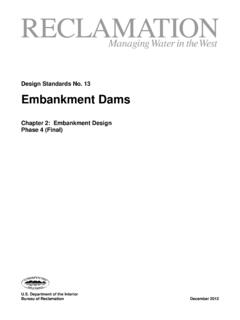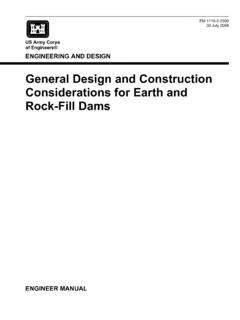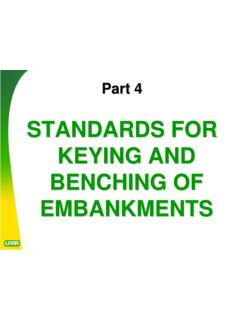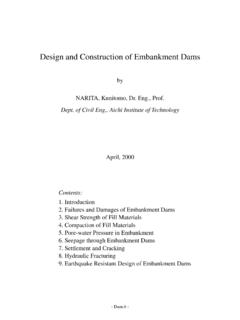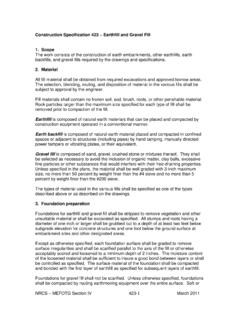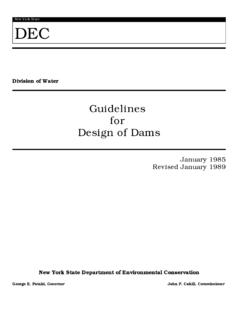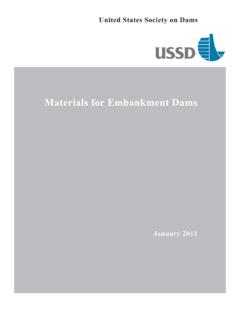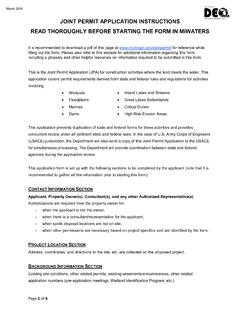Transcription of GUIDELINES FOR THE CONSTRUCTION OF EARTH-FILL DAMS
1 GUIDELINES FOR THE CONSTRUCTION OF EARTH-FILL dams Water Resources Policy Policy #2008/1 November 2008 Department of Primary Industries and Water State of Tasmania 2008 Water Resources Division Department of Primary Industries and Water GPO Box 44 Hobart TAS 7001 Phone: (03) 6233 6753, Fax (03) 6233 6055 Email: Home Page: ISBN 978-0-7246-6467-2 The Water Management Act 1999 ( the Act ) provides for the sustainable management and allocation of Tasmania s water resources. Amongst other things the Act provides for the promotion and fostering of social and economic benefits from the development of the State s water resources. With the commencement of the Act in 2000, a new process for assessing dam permit applications was established. Under the Act, a dam permit is generally required for all dams except in circumstances such as: a dam that is not on a watercourse and that holds less than one megalitre of water; or a dam constructed for the primary purpose of storing waste as defined in the Act.
2 In addition to a barrier across a watercourse, a "dam" includes an excavation in a watercourse and a flood levee, both of which also require a permit under the Act. Under the Act, a statutory committee, the Assessment Committee for Dam CONSTRUCTION (the Assessment Committee), was established as the body responsible for assessing applications for the CONSTRUCTION of dams . The Assessment Committee members have expertise in the management of water resources; the use and economic development of water resources; engineering and safety matters relating to dams ; integrated natural resource management; and best practice environmental management. The GUIDELINES for the CONSTRUCTION of EARTH-FILL dams detail the specifications for the CONSTRUCTION of EARTH-FILL dams , and outline the precautions and methods which should be employed in order to obtain the soundest possible structure.
3 These GUIDELINES will provide an overview for dam permit holders and existing dam owners of the major matters to be considered in the CONSTRUCTION of such dams . Dr Alan Harradine General Manager (Water Resources) Department of Primary Industries and Water TABLE OF CONTENTS 1. INTRODUCTION .. 1 Purpose of the GUIDELINES .. 1 Classification of EARTH-FILL dams .. 1 2. PLANNING AND MANAGEMENT SPECIFICATIONS .. 3 Introduction .. 3 Risk downstream of a dam .. 4 Contract .. 5 Easements & boundaries .. 5 Site investigations .. 5 Filling of the dam .. 6 Dam permit conditions .. 6 3. ENGINEERING AND CONSTRUCTION SPECIFICATIONS .. 7 Engineering .. 7 Clearing .. 8 Foundation* .. 8 Cut-off trench* or keyway .. 8 When to use filters .. 8 Rock .. 9 Outlet pipe .. 9 Outlet pipe materials and installation .. 10 Baffle plates on outlet pipes .. 10 Borrow pits.
4 11 Embankment compaction .. 11 Compaction testing requirements .. 12 Batter slope* .. 13 Settlement of the embankment .. 13 Vegetation .. 13 Spillway* or stream 14 Freeboard*.. 14 Protection from wave action .. 15 Sedimentation .. 15 Maintenance and inspections .. 15 Your engineer .. 16 4. ACRONYMS AND DEFINITIONS .. 18 Acronyms .. 18 Definitions .. 18 5. BIBLIOGRAPHY .. 19 Version Author Reason November 2008 Water Resources Division Policy 2008/#1 released GUIDELINES FOR THE CONSTRUCTION OF EARTH-FILL dams (November 2008) 1 1. INTRODUCTION Purpose of the GUIDELINES These GUIDELINES detail the specifications for the CONSTRUCTION of EARTH-FILL dams *, including precautions which should be taken and methods which should be employed in order to obtain the soundest possible structure. A dam permit may prescribe higher requirements for the CONSTRUCTION of an EARTH-FILL dam.
5 Therefore, unless otherwise specified in the dam works permit, the works should be undertaken, as far as relevantly possible, in accordance with the following specifications. If in doubt, specific advice should be sought from contractors, engineers or expert consultants. The specifications relate to general planning and management requirements as well as specific engineering and CONSTRUCTION specifications. CONSTRUCTION and all future safety management and maintenance of any dam must also be carried out in accordance with the Water Management (Safety of dams ) Regulations 20031. It should be noted that the soundness of the dam depends also on factors inherent in the site itself, the materials used and the methods of CONSTRUCTION . Although every reasonable precaution may be taken faults may yet develop. The Assessment Committee and DPIW and its officers accept no responsibility for anything which may occur during the building of the dam or afterwards.
6 Some of the terms mentioned in these GUIDELINES is marked with an asterisk (*), these are defined in the Definitions and Acronyms Section of this document. Classification of EARTH-FILL dams dams under the Australian National Committee on Large dams (ANCOLD) have specific hazard category ratings. The hazard category* of a dam is based on the risk to the downstream community and environment if the dam failed. In general terms, the higher the hazard category assigned to a dam means that more work will be required to assure that the risk to the downstream community in a dam breach situation is mitigated to an acceptable level. 1 The conditions on a dam works permit are based on the determination of a dam s hazard category, which is assessed generally in accordance with GUIDELINES published by the Australian National Committee on Large dams (ANCOLD).
7 GUIDELINES FOR THE CONSTRUCTION OF EARTH-FILL dams (November 2008) 2 The specific level of work required to be undertaken to address the hazard category of a dam is detailed in: Various ANCOLD GUIDELINES , as amended from time to time2. Water Management (Safety of dams ) Regulations 2003. Dam Works Code 2007 (DPIW 2007). Dam permit conditions. There are seven hazard groups defined within the ANCOLD GUIDELINES , which range from Low to Extreme . In general, there are three broad categories of dams based on the hazard category, reflecting the amount of work required for the operation of a safe dam: Category 1. dams that have a Very Low and Low hazard category. These still require a permit to undertake dam works, but in general, require the least amount of detail to satisfy statutory planning, CONSTRUCTION , maintenance and reporting requirements.
8 Category 2. dams that fall into a hazard category of Significant and High C , or all dams that are over 10 metres but less than 25 meters in height and are not in Category 3 below. These require considerably more detail to satisfy planning, CONSTRUCTION , maintenance and reporting requirements compared to those dam in Category 1 above. Category 3. dams that are at the higher end of the hazard category scale. These dams include High B , High A , Extreme hazard category dams and dams that are over 25 metres in height. These generally require the services of an expert dams team. The majority of farm dams fall into Category 1, but occasionally fall into Category 2. Larger dams such as some of the Hydro Tasmania dams and other water utility dams may fall into Category 3. 2 For example GUIDELINES on Assessment of the Consequences of Dam Failure (2000); GUIDELINES on the Selection of Acceptable Flood Capacity for dams (2000); and GUIDELINES on Dam Safety Management (2003).
9 GUIDELINES FOR THE CONSTRUCTION OF EARTH-FILL dams (November 2008) 3 2. PLANNING AND MANAGEMENT SPECIFICATIONS Introduction Many farm dams and other EARTH-FILL dams fail because of: poor planning; poor investigation; poor design; unsatisfactory siting; faulty or poor CONSTRUCTION practices; or, poor or lack of maintenance after CONSTRUCTION . It should be noted that the majority of dams that do fail, fail on first filling. Research undertaken to date suggest that 1 in 60 EARTH-FILL dams will experience some form of leakage that will generally require some form of expensive remedial work to be carried out during the life of the dam. It cannot be overstated that the ultimate responsibility for the CONSTRUCTION and ongoing operation of a dam lies solely with the permit holder who is generally the dam owner, and the general success of the dam starts in the planning stage when all the pre- CONSTRUCTION work is undertaken.
10 Neither the Department of Primary Industries and Water ( the Department ) nor the Assessment Committee for Dam CONSTRUCTION ( Assessment Committee ) undertake any design or planning for the CONSTRUCTION of a dam. Some tips for the dam owner to think about: In the planning stage if an issue is not clear, the owner should seek the services of an appropriately qualified and experienced professional. This may save a considerable amount of money and time in the long run. Properly read and understand the conditions of a dam works permit when granted. If it is not understood seek advice from an appropriately qualified and experienced professional. For dam safety reasons, dams must be built in accordance with the dam works permit conditions. The Department has the power under the Water Management Act 1999 to take various actions and to impose fines when dam permit conditions are not adhered to.

